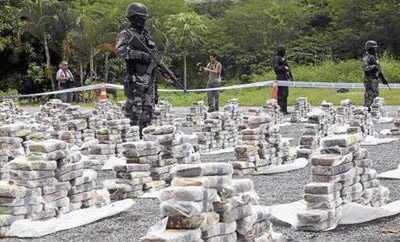Mexican and Colombian groups may soon start battling it out for control of drug trafficking routes in Ecuador, something that could further threaten the country’s already precarious security situation.
The drug trade through Ecuador has historically been controlled by Colombia’s criminal groups who, until recently, essentially held a monopoly over corridors moving through and out of the country. This is gradually changing however, with Mexican transnational criminal groups interested in moving further down the drug chain to cut out Colombian middlemen. As one anti-narcotics agent told El Comercio, “Colombian cartels no longer have the same power.”
Mexican gangs linked to Ecuador’s drug trade had traditionally played the role of buyers from Colombian cartels, due to the fact that they didn’t have the operational capacity to move their own product from Ecuador northwards, another anti-narcotics official told the newspaper.
However, this Colombian-dominated supply chain endured until some point in 2011, according to El Comercio. Now, intelligence sources suggest that Mexican cartels are trying to take complete control. As El Comercio notes, the arrest of three Mexicans and seizure of their ”go-fast” boat off the coast of San Vicente, Manabi in June, underscores how Mexican gangs now have the capacity to transport their own shipments. GPS data obtained from the boat indicated that the boat had left Mexico, stopped in Central America to refuel, before arriving in Ecuador.
This means previous alliances, such as that between the Colombian Rastrojos and Mexican Sinaloa Cartel, could break down as they battle each other for control of departure points and routes.
This is yet to turn into open confrontation. Instead, gangs are seeking to damage their rivals by tipping off Ecuadorean authorities on the locations of cocaine shipments. Between June and September this year, 1.9 tons of cocaine was seized in the coastal province of Manabi. Eighty percent of these seizures were the result of police paying $20,000-$40,000 to gang members for information on their competitor’s shipments, a high-ranking police official stated.
InSight Crime Analysis
If the disintegration of the relationship between Mexican and Colombian groups in Ecuador is true to the extent El Comercio states, Ecuador could be set for what could be a destabilizing confrontation. The US State Department’s 2011 International Narcotics Control Strategy Report estimated that 220 tons of cocaine pass through the country each year. While this figure may be on the high side, it is nonetheless representative of Ecuador’s importance as transhipment point and how highly prized it is for cocaine cartels.
Most interesting is the shift in dynamic this would represent. Jay Bergman, Andean regional director for the US Drug Enforcement Administration (DEA), told InSight Crime that the role of Colombian gangs as wholesalers is well established, with Mexicans typically controlling the trafficking routes. If Mexican groups attempt to move further down the supply chain, Colombian gangs are unlikely to give up their position without a fight.

They may be on the back foot, however, as the Mexican groups have been stepping up their presence in recent years. The capture of nine Sinaloa Cartel operatives last year in Ecuador and discovery of two alleged Mexican narco-planes in the past 12 months – one with 1.5 tons of cocaine on board, the other $4 million – is evidence of this.
The question, therefore, is whether Ecuador is prepared. An internal military report seen by El Comercio earlier this year found that Ecuadorean authorities had vastly underestimated the threat posed to the country by organized crime and that if “adequate measures” were not taken soon, the country could be overwhelmed by gang activity. Since the report, the government announced it would train around 4,000 troops to combat organized crime. This may still be insufficient, however, if Colombian and Mexican groups begin openly fighting.
One dynamic the El Comercio report failed to address is the role of the Revolutionary Armed Forces of Colombia (FARC) in Ecuador. The guerrillas have a strong presence along the border (see map, right), bringing coca base over from southern Colombia to sell on to Mexican groups. It is unlikely that Mexican cartels would challenge the guerrillas, who are not only heavily armed, but control most of the coca plantations on the Colombian side of the border.
For now, the confrontation is playing out in a clandestine manner. However, Mexican cartels have shown a wish to take greater control of the links further down the drug chain, to further maximize their profits. This may turn Ecuador into a battle ground between some of the most powerful criminal organizations in the hemisphere.

